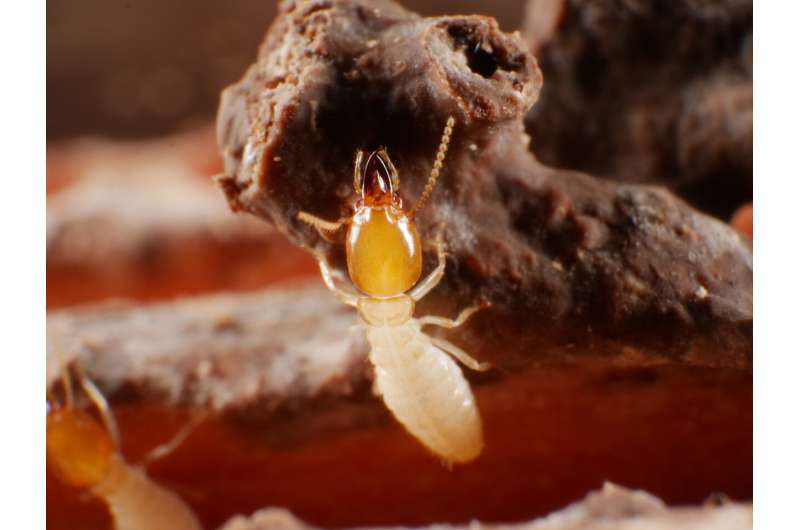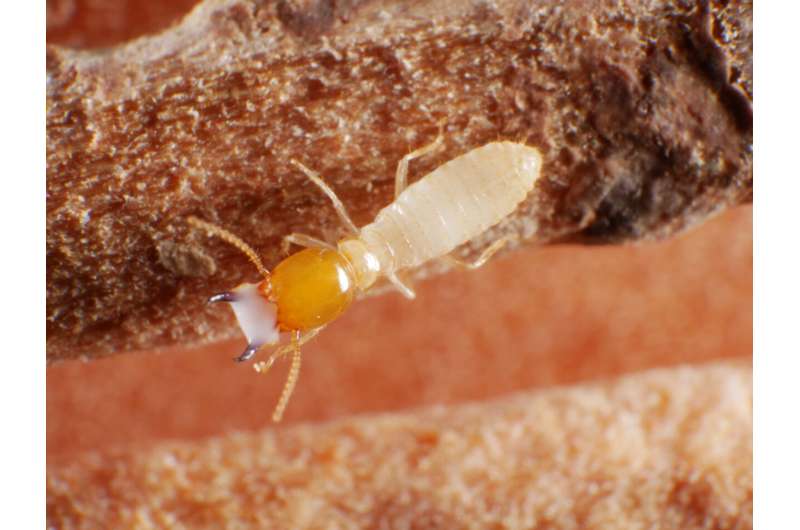This article has been reviewed according to Science X's editorial process and policies. Editors have highlighted the following attributes while ensuring the content's credibility:
fact-checked
peer-reviewed publication
trusted source
proofread
Researchers rewrite termite classification system

Termites have a bad reputation. Most think of them as pests, a status that isn't helped by their recent reclassification into the cockroach family.
But not only do the termites that cause serious problems for humans only make up 3.5% of all termite species, termites also serve as crucial ecosystem engineers, maintaining the infrastructure of various environments. Like earthworms, they circulate nutrients by decomposing plant materials, and they play the important role of bioturbators. Much like plowing a field, termites aerate the soil, expose underground nutrients, and let water infiltrate deeper layers of soil—all vital to plant life.
Termites are also exemplary builders; their mounds stay cool under the blistering sun, inspiring energy-free air conditioning systems in smart architecture.
Just as many ecosystems rely on the infrastructure provided by termites, so too does the study of termites require a solid foundation. And now, a new system for termite classification has been created thanks to the effort of no less than 46 researchers from across the world.
Their work, built on expert consensus and extensive data analyses, has been published in Nature Communications.
"We have resolved the ambiguity of the previous system with a modular and very robust classification of the termite family," says Dr. Simon Hellemans, lead author and member of the Evolutionary Genomics Unit at the Okinawa Institute of Science and Technology (OIST).
"With this new 'dictionary,' we have a solid platform from which we can study the diversification of termites and the roles they play in their ecosystems, as well as accommodate future discoveries."

A family reunited through distinction
Taxonomy, the scientific classification of groups (or taxa) of organisms, is an old discipline that underpins all biology: "If you want to observe anything in nature, you need [to] define your units of observation," as Dr. Hellemans puts it.
Classification may be arbitrary—the animal doesn't care if we label it Heterotermitidae or Rhinotermitidae—but it's a necessary categorization that allows researchers to limit the scope of their study and communicate clearly.
Until the introduction of modern DNA sequencing, these distinctions were usually based on morphological analyses, whereby organisms are classified by their physical characteristics and behaviors and placed in relation to one another based on similarities. But while it may be easy to determine how chimpanzees and humans are different from gorillas, visually determining the difference between two termites may be more difficult.
Over time, the subjectivity of morphological analysis has led to a convoluted family tree for termites. Some termites diversify very quickly, meaning that those species have evolved rapidly compared to others. And yet, just ten distinct families were identified, which had to accommodate a lot of morphologically distinct animals with unclear evolutionary relationships.

Three terms are used to describe the relationship between grouped species: monophyly, polyphyly and paraphyly. A monophyletic group of species shares a common ancestor; polyphyletic groups often share common characteristics, but not a common ancestor; and paraphyly describes groups that include a common ancestor as well as some—but not all—descendants.
The problem with termites, which is a monophyletic group within the cockroach order, is that the traditional classification is characterized by a great deal of paraphyly and polyphyly owing to the confusion over evolutionary relationships.
"Thanks to extensive data analysis and new morphological surveys, we managed to eliminate paraphyly and polyphyly in the termite family tree entirely by splitting up the larger subfamilies," explains Dr. Hellemans, "and in doing so, we have created a system that can effectively accommodate the discovery of new lineages while preserving historical family and subfamily names. This is key to providing a stable termite nomenclature. Taxonomy is also built on historical records, so this is very important."
Every family and subfamily within the new termite tree of life is monophyletic, clearing up the evolutionary relationships between the species and making it significantly easier to slot in newly discovered or reclassified species.
The new tree also underscores the diversity of termites, which allows for much greater precision in research and pest control. For example, the Coptotermes gestroi, a destructive pest species of termites, was initially classified in the Rhinotermitidae family along with the non-pest Dolichorhinotermes longilabius due to their morphological similarities.
However, early phylogenetic studies suggested that these two species might not be closely related, which has now been confirmed through more advanced phylogenetic and morphological surveys, which reclassified C. gestroi into the Heterotermitidae family.

Building the foundation together
Rewriting the dictionary of life is no simple feat. More than anything, it takes consensus—after all, a dictionary is useless if there's disagreement over the definitions.
The work to update the termite tree of life began during a symposium at OIST in 2022, which was organized by Professor Tom Bourguignon, head of the Evolutionary Genomics Unit. Here, the unit proposed a framework for revising the tree of life, which included both morphological surveys and data analyses powered by the supercomputer at OIST.
Phylogenetic revisions of classification systems are often based on a data model that can take weeks for a supercomputer to calculate, and each time an adjustment is made, the processing begins anew.
"Our classification is based on the convergence of 51 models, each of which took around two weeks to compute," recounts Dr. Hellemans. "This was only possible thanks to Deigo, which allowed us to run the analyses in parallel."
Deigo is the name of the main supercomputing cluster operated by the OIST Core Facilities, named after the prefectural flower of Okinawa and available to all OIST researchers.
"Phylogenetics cannot stand alone," says Dr. Hellemans.
While the researchers used computational models of DNA markers to ascertain the evolutionary relationship between the families, the models do not account for the termites' habits nor the roles they play in their environments. This knowledge was instead provided by the human experts who have dedicated their lives to one subset of our living world and who have an invaluable, scientific familiarity with the species they study.
Dr. Hellemans concludes, "Even if it was difficult to coordinate a collaborative project of this size, the new termite classification system is greater than the sum of its parts. With this, we have a much stronger framework for the study of these important ecosystem engineers."
More information: Simon Hellemans et al, Genomic data provide insights into the classification of extant termites, Nature Communications (2024). DOI: 10.1038/s41467-024-51028-y
Journal information: Nature Communications
Provided by Okinawa Institute of Science and Technology



















